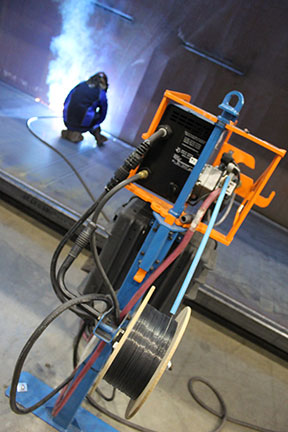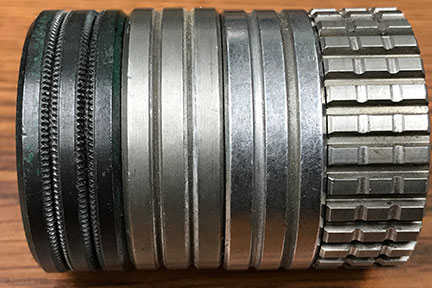Choosing the Right Drive Roll Is Key for Smooth Wire Feeding

Drive rolls are an important part of the wire-feeding system — integral to smooth and consistent wire feeding. Using the right type of drive rolls for the chosen wire can impact productivity, quality and efficiency — and help save time and money for troubleshooting and maintenance.
It’s not uncommon for welding operators to ask: What is causing my wire-feeding issues?
Poor feedability, birdnesting, burnback and clogging of the gun liner are among the challenges that welding operators may face with wire welding processes. These issues can result in costly downtime, increased time spent on weld cleanup due to excessive spatter — or even defects in the weld.
Sometimes, these issues stem from using the wrong type or size of drive rolls for the job, or from improper drive roll tension.
Choosing the right drive roll
The three types of drive rolls most commonly used for wire welding processes are V-knurled, V-groove and U-groove.
V-knurled drive rolls are used with gas- and self-shielded flux-cored and metal-cored wires, which are softer due to the flux inside and the tubular design. This type of drive roll has teeth to dig into the wire and help push it through the feeder drive system and gun cable. V-knurled drive rolls are not typically used with solid wire and may cause shavings to break off the wire. Those shavings can clog the liner and negatively impact wire feeding.
V-groove drive rollsare normally used with solid wire. The extra push provided by V-knurled drive rolls is not needed with solid wire, which is stiffer and tends to feed better through the liner.
U-groove drive rollsare designed for use with aluminum wires or other very soft materials. When using soft wires such as aluminum, it’s important to avoid marring the wire surface or deforming or mashing the wire. A U-groove drive roll helps to feed the wire through the liner while still keeping the wire’s round shape.
There’s also a fourth, less common, type: U-cogged drive rolls. These are similar to V-knurled drive rolls in that they have teeth to feed soft wires. U-cogged drive rolls can be used to feed very large diameter, very soft cored wires.

Best practices for success
Following some key best practices can help prevent issues with wire feeding.
Along with selecting the right type of drive roll, it’s also important to choose a drive roll that matches the size of the wire being used. A drive roll that is too big or too small for the wire can lead to feeding problems.
In addition, setting proper drive roll tension is essential. Drive rolls are designed to feed the wire smoothly from the wire spool into the gun cable. Setting the drive roll tension too tight can deform the wire, which can result in arc instability or burnback. Too little tension also can be problematic and cause wire slippage.
To set the proper tension, begin by releasing all tension on the drive rolls. Then increase the tension while feeding the wire into a block of wood, continuing to increase the tension one half-turn past wire slippage. Make sure to properly set the tension each time the drive roll is changed.
Most feeders now come installed with an inlet guide and/or intermediate guide, which help guide the wire into the drive rolls properly. These guides are designed to work with a range of wire sizes, so make sure the guides being used are properly sized for the wire as well.
Lastly, occasionally cleaning the drive roll surface with a wire brush can also help maintain proper wire feeding.
Remember, drive rolls are an important part of smooth, consistent wire feeding. Take care to choose the right style and size of drive roll — and to set it up properly — to help prevent poor wire feeding and any associated downtime or costs.



